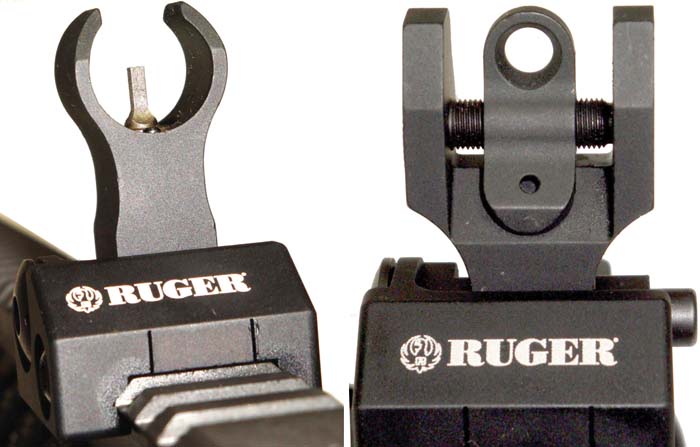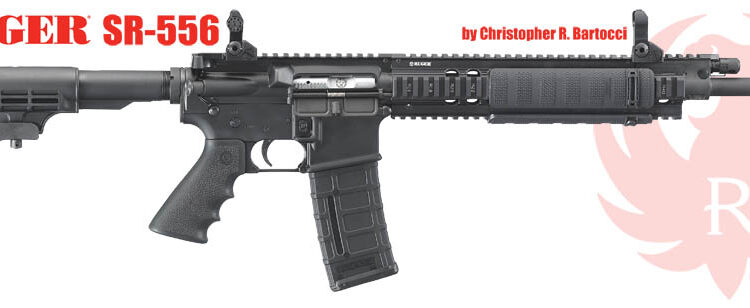By Christopher R. Bartocci
At the NRA Show in early 2009, Ruger introduced a new member to their semiautomatic rifle line: the SR-556 – Ruger’s Black Rifle. When they took on the task, they decided not to reinvent the wheel and go with the proven direct gas system but to go with a short stroke tappet piston system instead. The last few years both the defense communities as well as all walks of combat rifle users have debated on what is the best operating system for this platform: direct gas or a piston operated action. Many manufacturers were quick to introduce piston guns to the market with hopes to derail the M4 carbine and M16 series rifle from U.S. service and replace it with a piston operated weapon. Some of the pioneers of introducing piston operated weapons were Heckler & Koch, LWRC and POF. Later, ARES would come out with a retrofit kit, and so on.
Without getting too much into the controversy, there was certainly enough smoke stirred up to get people to look at both operating systems. Detractors of the direct gas system will state that the piston operated weapons will run cooler and cleaner requiring less maintenance and therefore last longer. The main difference between the two systems is where the gas is taken to operate the bolt. The direct gas mechanism creates an expansion chamber between the back of the bolt and carrier thus putting hot propellant gases into the action of the weapon. The piston operated weapon keeps the gas in or around the gas block, therefore not introducing the gas into the action. All points are arguable but this decision is best left to the user.

The SR-556
The SR-556 is chambered for the 5.56mm cartridge and equipped with a 16.12 inch cold hammer forged 41V45 Chrome-Moly-Vanadium steel barrel. The barrel is chrome lined and has a 1-turn-in-9 inch twist rate. The barrel is equipped with a proprietary Ruger AC-556 flash suppressor. The SR-556 utilizes the Troy Industries 10-inch quad handguard that is pinned to the upper receiver. This particular handguard was designed and sold only to Ruger for their new rifle. Along with the rail came three Troy Industry rail protectors. A Troy Industries folding front sight was attached to the front of the top rail of the handguard. The profile is similar to that of an AK with the much larger “rabbit ears” that protect the front sight post.
The rifle is gas operated and fires by the short stroke tapped method of operation. The regulator and piston are held into the front sight base by the captive regulator pin. The regulator has four positions: Position 0 allows for single shot only by shutting off the gas port causing the weapon to be manually cycled. Position 1 is the smallest of the settings. Position 2 is the optimum setting for most commercially available ammunition. Position 3 is the largest for under- powered ammunition or if the weapon is extremely dirty. Ruger recommends the regulator should be set to the smallest setting that will effectively cycle the weapon. Leaving the regulator on the largest setting will “over gas” the rifle and degrade the service life of the weapon. The SR-556 is one of the few piston operated AR-platform weapons to use an adjustable regulator. During testing of the rifle, position 2 was used and the rifle reliably fired all ammunition that it was fed. The most curious thing discovered in the examination of the SR-556 was the inability to remove the operating rod and spring for cleaning and maintenance. In order to do so, the flash suppressor would have to be removed, the taper pins removed and front sight base removed from the barrel. According to Ruger, there is no need to access the operating rod for cleaning or lubrication. The operating rod is nickel-Teflon coated for both lubricity and rust resistance. The operating rod spring is made from stainless steel. When the action cycles, the operating rod is self cleaning.

The upper receiver is the standard M4-type with a flat op Mil-Std 1913 rail. The upper has the forward bolt assist as well as the fired cartridge case deflector. A Troy back-up sight is attached to the rear of the upper receiver.
The bolt carrier group is rather unique. The chrome plating of the bolt and carrier are similar to the finish on the original model 01 AR-15 rifles, M16 and XM16E1 rifles. This boasts ease in cleaning. The carrier is one solid piece with the carrier key machined into the bolt carrier which strengthens the key from the impact of the piston. The rear of the carrier is flared out to lessen the bolt carrier tilt which is caused by the off center impact of the operating rod tipping the bottom rear edge of the carrier into the receiver extension and damaging it. The carrier has forward assist notches on the right side as well. The bolt has the gas key area turned down and the extractor uses a rubber o-ring around the extractor spring. The carrier is a semiautomatic only carrier.

The lower receiver is similar to any other AR-type lower receiver. The pistol grip monogrip manufactured for Ruger by Hogue is extremely comfortable and is much more comfortable than the standard A2-style pistol grip. The stock is a standard GI-type sliding buttstock with the enhancement of a receiver extension allowing 6 adjustable positions. This is most beneficial to those wearing tactical vests or body armor. The buffer used is a standard carbine buffer with three steel weights. The trigger was the standard combat trigger but it was unusually smooth and had a crisp break for this type of a trigger.
To my most pleasant surprise were the magazines which the SR-556 comes standard: the Magpul PMag. Three of these magazines accompanied the rifle. Perhaps the most reliable and durable magazine ever put out for this weapon system, the PMag will boost the reliability of any Black Rifle. The constant curve technology combined with an indestructible polymer makes this the perfect mate for any new high speed weapon system. These magazines have been previously tested and the reliability is unsurpassed.

Overall impressions of the new rifle were impressive. The rifle is extremely well made and the fit and finish was top rate as one would expect to see from Ruger. The rifle came equipped with everything you needed including rail covers and back-up front and rear sights. The barrel suppressor and gas system give the SR-556 its own unique look. All high end accessories were put on the rifle making it ready to mount up an optic and tactical light and put in a squad car. Clearly, the SR-556 is not configured to fire selectively based on its current design and, according to Ruger, there are no current plans to offer the rifle in a select fire variation.
The optic chosen to test the SR-556 was the Trijicon ACOG (TA31RCO-A4CP) Marine Corps scope. The scope provided both tritium as well as fiber optic power to light the red chevron reticle. The test ammunition was manufactured by Silver State Armory and Black Hills. Function testing was conducted with Silver State Armory 5.56mm 55gr. FMJ ammunition. Some 300 rounds were fired with no malfunctions of any sort. Accuracy testing was done off of a bench at 100 yards. Silver State Armory 77gr. OTM and Black Hills MK262 MOD1 77gr. OTM ammunition was used. Retired Marine Sniper Sergeant Major Chris Gagliano was able to fire at nearly 1-1/2 inch groups at 100 yards with the 4×20 power ACOG. This is very respectable groups for any tactical rifle. With a higher power accuracy it is reasonable to expect the group sizes would have decreased even further.

Silver State Armory, LLC of Pahrump, Nevada provided the test ammunition for this article. This was the first time this author had used this ammunition. Upon examination of the ammunition, SSA (Silver State Armory) manufactures their own brass for most of their ammunition. The brass is match grade quality and they do sell it to reloaders. Most of the ammunition made in 5.56mm is tactical ammunition, not necessarily target ammunition but they do have a 5.56mm M193-equivalent which was used for function testing. Group size was very respectable at approximately 1-3/4 to 2 inches off of a bench at 100 meters. Silver State Armory manufactures match as well as duty grade ammunition in 6.8 SPC, 7.62x51mm NATO and .499 LWRC calibers. SSA also manufactures armor piercing cartridges for military and law enforcement.
The SR-556 will undoubtedly find its fans in the United States. This legendary arms maker has entered into the black rifle market and put their own spin on it giving a uniquely different product to the consumer. Ruger offers this as a commercial as well as a military rifle. The acceptance with law enforcement is way too early to tell. The impingement versus piston saga will most certainly continue with each having their supporters. This is just another way to accomplish the same job. The accuracy was superb and no malfunctions were encountered in shooting this new weapon. I expect the SR-556 to be a contender with any person or agency who wants a piston operated black rifle.





| This article first appeared in Small Arms Review V13N5 (February 2010) |












